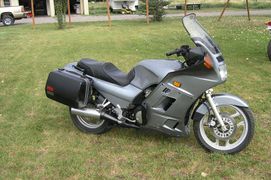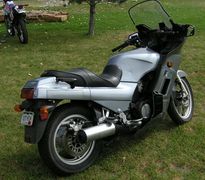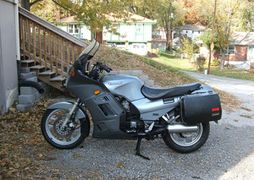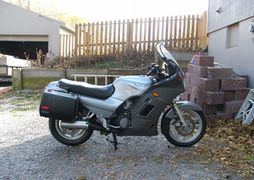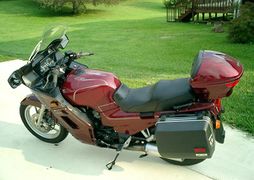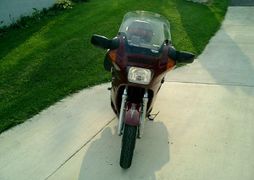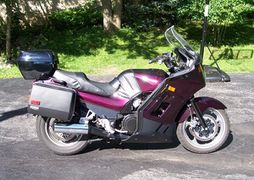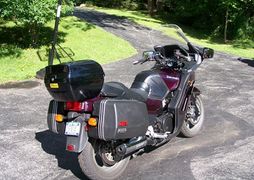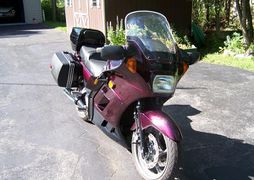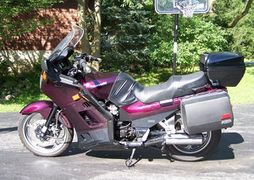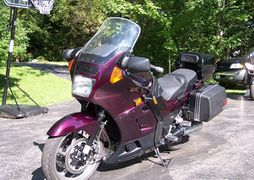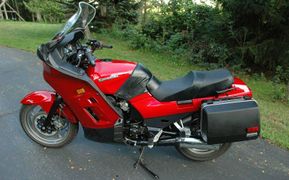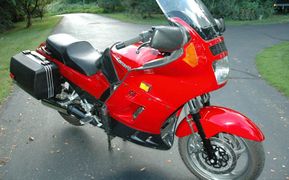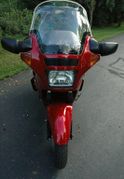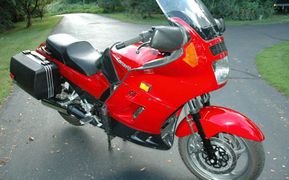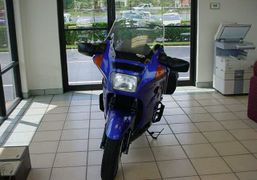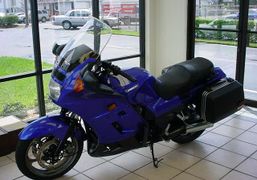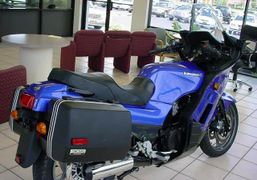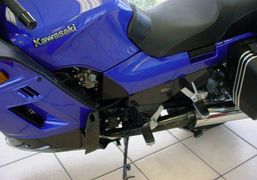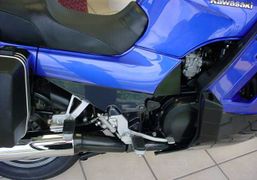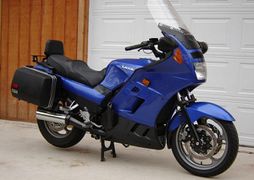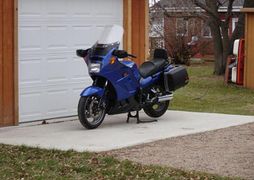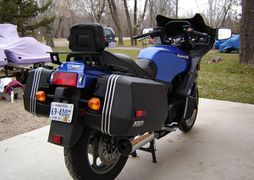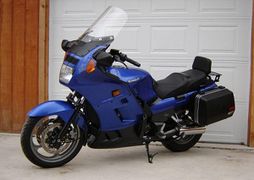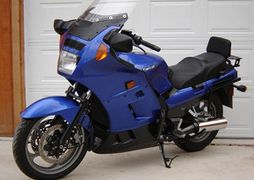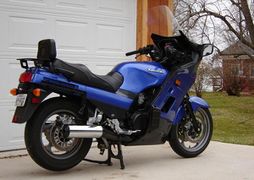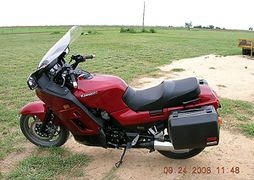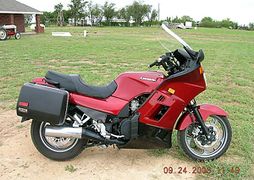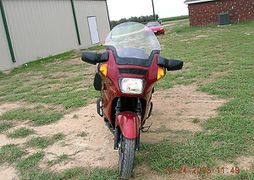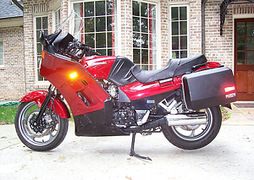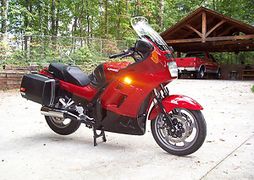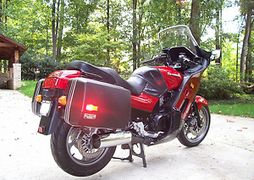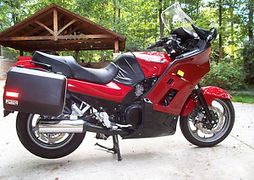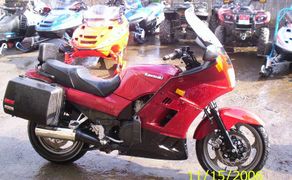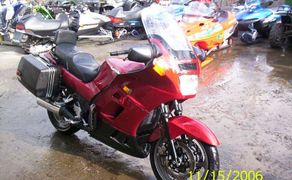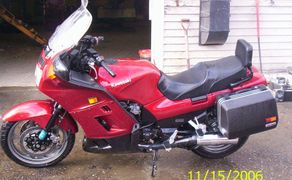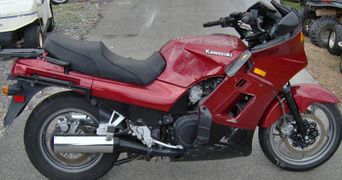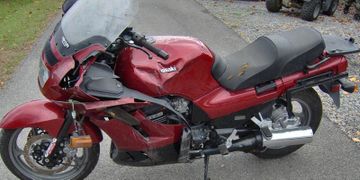|
|
| Line 1: |
Line 1: |
| {{Motorcycle | | {{Motorcycle |
| |name = Kawasaki ZG1000A | | |name = Kawasaki ZG1000 Concours |
| |photo = 2004Concours.jpg | | |photo = 2004Concours.jpg |
| |aka = GTR1000, Concours | | |aka = GTR1000, Concours, ZG 1000 |
| |manufacturer = [[Kawasaki]] | | |manufacturer = [[Kawasaki]] |
| |parent_company =
| |
| |production = 86-06
| |
| |model_year =
| |
| |predecessor =
| |
| |successor =
| |
| |class =
| |
| |engine = 1000cc
| |
| |bore_stroke =
| |
| |compression =
| |
| |top_speed =
| |
| |power =
| |
| |torque =
| |
| |ignition =
| |
| |spark_plug = {{sparkplug|NGK BA8ES}} '86<br />{{sparkplug|NGK D8EA}} '87-95 , '98-06
| |
| |battery = {{battery|NGK YB18L-A}} '86-95 , '98-06
| |
| |transmission =
| |
| |frame =
| |
| |suspension =
| |
| |brakes =
| |
| |front_tire = {{tire|120/70-18}} '98-06<br />{{tire|110/80-18}} '86-95
| |
| |rear_tire = {{tire|150/80-16}} '86-95 , '98-06
| |
| |rake_trail =
| |
| |wheelbase =
| |
| |length =
| |
| |width =
| |
| |height =
| |
| |seat_height =
| |
| |dry_weight =
| |
| |wet_weight =
| |
| |fuel_capacity =
| |
| |oil_capacity =
| |
| |oil_filter = K&N KN-401
| |
| |fuel_consumption =
| |
| |turning_radius =
| |
| |related = [[Kawasaki GTR1000]]
| |
| |competition =
| |
| }}
| |
|
| |
|
| |
| {{Infobox Motorcycle
| |
| |name = [[Kawasaki]] ZG1000 Concours
| |
| |image = [[File:Kawasaki-GTR1000-86--2.jpg|frameless|Kawasaki ZG1000 Concours]]
| |
| |aka = ZG 1000 Concours
| |
| |manufacturer = Kawasaki
| |
| |parent_company = | | |parent_company = |
| |production = 1986 - 89 | | |production = 1986 - 89 |
| Line 62: |
Line 18: |
| |fuel_system = | | |fuel_system = |
| |ignition = Electronic | | |ignition = Electronic |
| |spark_plug = | | |spark_plug = {{sparkplug|NGK BA8ES}} '86<br />{{sparkplug|NGK D8EA}} '87-95 , '98-06 |
| |battery = | | |battery = {{battery|YUASA YB18L-A}} '86-95 , '98-06 |
| |transmission = 6 Speed | | |transmission = 6 Speed |
| |frame = | | |frame = |
| Line 69: |
Line 25: |
| Rear: UNI-TRAK with adjustable preload, [[rebound damping]] and air pressure | | Rear: UNI-TRAK with adjustable preload, [[rebound damping]] and air pressure |
| |brakes =Front: 2x 272mm discs 1 [[piston]] [[caliper]] <br>Rear: Single 280mm disc 1 piston caliper | | |brakes =Front: 2x 272mm discs 1 [[piston]] [[caliper]] <br>Rear: Single 280mm disc 1 piston caliper |
| |front_tire = {{tire|110/80 VR18}} | | |front_tire = {{tire|120/70-18}} '98-06<br />{{tire|110/80-18}} '86-95 |
| |rear_tire = {{tire|130/80 VR16}} | | |rear_tire = {{tire|150/80-16}} '86-95 , '98-06 |
| |rake_trail = | | |rake_trail = |
| |wheelbase = 1554 mm / 61.2 in | | |wheelbase = 1554 mm / 61.2 in |
| Line 81: |
Line 37: |
| |fuel_capacity = 28.5 Liters / 7.5 US gal | | |fuel_capacity = 28.5 Liters / 7.5 US gal |
| |oil_capacity = | | |oil_capacity = |
| | |oil_filter = K&N KN-401 |
| |fuel_consumption = | | |fuel_consumption = |
| |turning_radius = | | |turning_radius = |
| Line 86: |
Line 43: |
| |competition = | | |competition = |
| }} | | }} |
|
| |
| It could reach a top speed of 216.0 km/h / 134 mph.
| |
|
| |
| ==Engine==
| |
| The engine was a Liquid cooled cooled Four stroke, transverse four cylinder, DOHC, 4 valves per cylinder.. The engine featured a 10.2:1 [[compression ratio]].
| |
|
| |
| ==Chassis==
| |
| It came with a 110/80 VR18 front [[tire]] and a 130/80 VR16 rear tire. Stopping was achieved via 2x 272mm discs 1 piston caliper in the front and a Single 280mm disc 1 piston caliper in the rear. The front suspension was a 41mm Telescopic, air-assisted adjustable preload while the rear was equipped with a UNI-TRAK with adjustable preload, rebound damping and air pressure. The ZG1000 Concours was fitted with a 28.5 Liters / 7.5 US gal fuel tank. The bike weighed just 270 kg / 595 lbs. The wheelbase was 1554 mm / 61.2 in long.
| |
| == Photos ==
| |
| [[File:Kawasaki-GTR1000-86--2.jpg|600px|Kawasaki ZG1000 Concours]]
| |
| [[File:Kawasaki-GTR1000-86--1.jpg|600px|Kawasaki ZG1000 Concours]]
| |
| [[File:Kawasaki-GTR1000-86--3.jpg|600px|Kawasaki ZG1000 Concours]]
| |
|
| |
| == Overview ==
| |
| Kawasaki GTR 1000 / ZG 1000 Concours
| |
|
| |
|
| |
|
| |
|
| |
|
| |
|
| |
|
| |
|
| |
|
| |
|
| |
|
| |
|
| |
|
| |
|
| |
|
| |
|
| |
|
| The Kawasaki Concours, known in Europe as the GTR1000 and in USA as the | | The Kawasaki Concours, known in Europe as the GTR1000 and in USA as the |
| Line 140: |
Line 67: |
| The GTR1000 has 1020 percent less horsepower than the US Concours, varying | | The GTR1000 has 1020 percent less horsepower than the US Concours, varying |
| by country | | by country |
| | It could reach a top speed of 216.0 km/h / 134 mph. |
|
| |
|
| | ==Engine== |
| | The engine was a Liquid cooled cooled Four stroke, transverse four cylinder, DOHC, 4 valves per cylinder.. The engine featured a 10.2:1 [[compression ratio]]. |
|
| |
|
| | ==Chassis== |
| | It came with a 110/80 VR18 front [[tire]] and a 130/80 VR16 rear tire. Stopping was achieved via 2x 272mm discs 1 piston caliper in the front and a Single 280mm disc 1 piston caliper in the rear. The front suspension was a 41mm Telescopic, air-assisted adjustable preload while the rear was equipped with a UNI-TRAK with adjustable preload, rebound damping and air pressure. The ZG1000 Concours was fitted with a 28.5 Liters / 7.5 US gal fuel tank. The bike weighed just 270 kg / 595 lbs. The wheelbase was 1554 mm / 61.2 in long. |
|
| |
|
|
| |
|
| | == Overview == |
|
| |
|
| The sport tourer is the least clearly defined of all motorcycles. It's
| |
| obvious which bikes fall into the super-sports or Grand Prix replica categories,
| |
| but counting the number of true sports-tourers will leave you with several spare
| |
| fingers on one hand.
| |
| By sports-tourer I mean something that is capable of carrying you 600 miles
| |
| in one day without leaving you feeling as if you've been through a mangle, but
| |
| is also capable of acquitting itself well on fast, twisting A-roads
| |
| against the likes of GPZ, VF, and GSX sportsters. I've always regarded the term
| |
| sports-tourer as a misnomer when applied to bikes like the FJ1100, K100RS and
| |
| XJ900. They are all able to fulfill both functions but compromise either comfort
| |
| or handling, excelling neither as sportster nor tourer. I thought there was no
| |
| such thing as a real sports-tourer - until I rode the Kawasaki 1000GTR. Here,
| |
| finally, we have what I would term a real sports-tourer; a motorcycle
| |
| that combines all the qualities of a superb tourer with all the qualities of a
| |
| big sportster.
| |
| The 1000GTR caused quite a stir when it first appeared at last year's Paris
| |
| Show, not least because it was claimed to be the result of a lot of European
| |
| input and its striking resemblance to a BMW. Indeed, the provisional spec was so
| |
| impressive (soft-tuned GPZ1000 motor, shaft drive, GPZ900-type frame and full
| |
| touring extras) that there was a lot of bitching going on in the office as to
| |
| who would be the lucky one to go out to Italy to ride it. It was only rumours,
| |
| that turned out to be totally without substance, of a Honda VFR750 launch in
| |
| Australia that kept most editors at home while us minions went on the GTR
| |
| launch.
| |
| What a great idea it was to launch the bike in Sicily. While the rest of
| |
| Europe suffered sub-zero temperatures and inches of snow we basked in bright
| |
| sunshine and notched up over 600 miles over lovely roads on the GTR. The plan
| |
| was to put in a day's riding in Sicily, spend another day riding up to Salerno
| |
| (a 350 mile autostrada dash), and then spend two days riding around the
| |
| hills of Campania. An excellent itinerary that took in all the road conditions
| |
| anyone is likely to encounter, either in Britain or on the continent.
| |
| The first thing you notice about the 1000GTR (apart from its likeness to a
| |
| BMW) is the size of the thing: the fairing is big, the tank is big, the seat is
| |
| big, the panniers are BIG, even the silencers are big. As I rolled it off the
| |
| centre stand I knew this was a big bike; the seat height is just over 32
| |
| inches and fuelled up it weighs in at just under 6501b. If I'd been less
| |
| substantial than my 6ft lin and 12and a 1/2 stone, the whole' lot would've
| |
| crashed to the ground there and then as it lurched sideways and my right foot
| |
| scrabbled for grip on the loose surface. The moment you start moving all the
| |
| weightiness disappears and the GTR suddenly becomes agile; even at low speeds
| |
| the steering was light and precise - something I hadn't expected from a bike
| |
| that size and with an 18-inch front wheel.
| |
| Once you're rolling, the next surprise (this bike was a constant source of
| |
| surprises) is the tractability of the motor. This is basically a GPZ1000RX
| |
| powerplant with a few top-end mods to give the GTR a claimed 12 per cent
| |
| increase in power and torque over the GPZ up to 7000rpm. These changes include
| |
| smaller airbox and carbs (32mm versions of the CVKs used on all the GPZ range),
| |
| different cams giving reduced duration and lift, and smaller diameter exhaust
| |
| header pipes. So the engine has been tuned to produce more horsepower and torque
| |
| than the RX at lower revs. Kawasaki claim 72.3ftlb (l0kgm) at 6500rpm (2000rpm
| |
| lower than the RX) and 108.5hp at 9500rpm (the same peak revs as the RX). The
| |
| rest of the motor remains the same as the GPZ1000 with identical bore and
| |
| stroke, pistons and compression ratio.
| |
| These top-end changes make the GTR much smoother and willing than its GPZ
| |
| brother at low revs. The 1000RX was decidedly glitchy below 4000rpm, whereas the
| |
| GTR will bimble along in sixth at 800rpm and pull strongly from around
| |
| two-and-a-half grand. That's the difference between an out-and-out sportster and
| |
| a sports-tourer. The willingness of the GTR's motor to pull from any revs was
| |
| illustrated beautifully on the coast road from Salerno to Sorrento. This is a
| |
| breath-taking road that winds its way along the sides of the mountains which
| |
| plunge vertically into the Mediterranean. The road is about 30 miles of mostly
| |
| blind hairpin bends connected by the occasional 50-yard straight, so speeds in
| |
| excess of 40mph were definitely not recommended. Swooping along on the GTR was a
| |
| real revelation it was so effortless. All I had to do was stick it in third gear
| |
| and let the motor pull round the corners and up the straights. I think the bike
| |
| stayed in third for the full distance, with only the occasional downchange for a
| |
| particularly tight hairpin.
| |
| Although the Kawasaki has a six-speed box, top gear is really an overdrive.
| |
| The GTR will go up to an indicated 140mph much quicker in fifth gear than it
| |
| will in top, and once you get to the desired speed you just snick it into sixth
| |
| and slot into cruising mode. In fact the GTR won't pull anywhere near the red
| |
| line in top, the most I had out of it was just over 140mph at a tad over
| |
| 8000rpm. Even down-changing to fifth and giving it some severe grief wouldn't
| |
| nudge the tacho or top speed any higher.
| |
| Indulging in these high speeds highlighted the only two criticisms I can
| |
| level at the Kawasaki - high-speed stability and vibration. The GTR was rock
| |
| steady up to 110mph, but above that would oscillate slightly and took a while to
| |
| settle down after it had been set snaking. Taking the panniers off or putting a
| |
| pillion on improved matters somewhat, and I suspect that fine-tuning the
| |
| suspension setting (something we weren't encouraged to do) would iron out this
| |
| particular gripe.
| |
|
| |
|
|
| |
| The suspension is handled at the back by Kawasaki's now familiar Uni-Trak
| |
| system, although this is the first time it's been used on a shaftie. As per
| |
| GPZ600,900 and 1000s, the Uni-Trak has air-assisted preload and four-position
| |
| rebound damping, but unlike the system on the 1000RX the shock is only
| |
| compressed from the bottom, not from both ends. Up front all the work is done by
| |
| a pair of linked, air-assisted, 41mm forks. Unlike the GPZ range, the GTR
| |
| doesn't feature Kawasaki's Advanced Variable Damping System, but it doesn't
| |
| suffer for that.
| |
| My other moan about the GTR is the vibration that's felt at high speeds. The
| |
| bike feels smooth up to around 120mph, but above that, when the revs get up to
| |
| 7000, tingling vibrations can be felt through the bars despite the bar-end
| |
| balancers. This slight buzz can be attributed to the fact that unlike the
| |
| 1000RX, which has a rubber-mounted engine in a cradle frame, the GTR's engine is
| |
| slung in a diamond-type frame similar to that of the GPZ900 and uses the engine
| |
| as a stressed member. The result of this is that the engine can't be
| |
| rubber-mounted and consequently buzzes like the GPZ900 at higher revs (all of
| |
| which is academic, because few people are going to keep up speeds of over 120mph
| |
| for any length of time, however easy it might be on the GTR).
| |
| Despite being basically bits of GPZ1000 and 900 cobbled together with a shaft
| |
| drive adapted from a GT750 and the US-spec Eliminator, the GTR feels remarkably
| |
| together in the handling department. It coped superbly with everything I threw
| |
| at it, which ranged from 120mph autostrada sweepers to 20mph hairpins.
| |
| The first day's riding was for the cameras, so it was decided to set up a couple
| |
| of cornering shots on tight righthanders to illustrate the GTR's cornering
| |
| abilities. Unlike any tourer I've ridden, the Kawa could be stuffed into tight,
| |
| bumpy bends very easily, and very quickly. I found I could indulge in
| |
| serious scratching antics normally reserved for balls-out sportsters, and
| |
| although the ground clearance is excellent, after a few passes the GTR was going
| |
| round the bends with the footrests or centre stand on the deck. Try that on a
| |
| BMW RT and you'll find yourself in big-time trouble.
| |
| Much of the GTR's cornering capability must be down to the super-smooth shaft
| |
| drive. Because the shaft and swingarm are very long, the effect of the shaft
| |
| loading and unloading the rear shock is minimized to the degree that it's
| |
| noticeable only under very heavy acceleration or braking.
| |
| Sweeping round a slow hairpin on a trailing throttle and then blasting out of
| |
| it and on to the next won't have the back end pogoing all over the place,
| |
| there's just an almost imperceptible lift at the back. No other shaft-driven
| |
| bike, except maybe the old Suzuki GS850, has such smooth transmission, and it
| |
| makes BMW and Moto Guzzi shafts seem prehistoric.
| |
| It's not just slow corners that the GTR is good on, either. Anyone who has
| |
| ridden on Italian autostradas will know that they are more like two-lane
| |
| A-roads than motorways, with lots of tight bends (none of which are constant
| |
| radius) and a wide variety of surfaces. On one occasion, I went into a very fast
| |
| sweeper only to find it tightened up in an horrendous fashion and disappeared
| |
| off to the left. To avoid going in through the driver's door of a Fiat Uno
| |
| tootling along in the slow lane required a rapid, and none too subtle tightening
| |
| up of line, something the GTR accomplished without so much as a twitch or
| |
| complaint. It was a fairly close call, but illustrated just how well the
| |
| Kawasaki can be made to change course, even at 120mph.
| |
| Of course it's on the autostradas that the fairing really comes into
| |
| its own. Fortunately, for the purposes of road testing at least, the last day's
| |
| riding was done mostly in pouring rain, with the odd shower of sleet and snow
| |
| thrown in for good measure. So we had ample opportunity to assess the fairing's
| |
| protective capabilities - and capable it certainly is. Bearing more than a
| |
| passing likeness to that of the K100RT, the fairing offers almost total weather
| |
| protection without being overly wide and bulky. The screen is high enough to
| |
| deflect air over any rider under six feet and creates a large pocket of still
| |
| air. As I'm over six feet tall, I found that my helmet took a bit of a
| |
| battering, but Kawasaki UK say that they may be offering a slightly higher
| |
| screen as an extra at a later date.
| |
| After four hours' riding in the rain and snow I would expect to be fairly
| |
| comprehensively drenched, however good a fairing might be. But not on this
| |
| Kawasaki. Unlike the K100RT, the GTR protects your feet, and if you keep the
| |
| balls of your feet up on the pegs they'll keep dry during short showers. It
| |
| takes a couple of hours before the rain gets through your boots. The only other
| |
| part of me to get wet was the underneath of my wrists and forearms when the rain
| |
| eddies round the fairing. The pieces of trim down either side of the fairing
| |
| that deflect the elements still further away from the rider are a particularly
| |
| nice touch. In hot weather these are detachable and different pieces can be
| |
| fitted which deflect cooling air onto the rider. A brilliant piece of design
| |
| that other manufacturers would do well to emulate.
| |
| The rest of the fairing is similarly well thought out, with a small grille
| |
| below the screen to aim cooling air at the rider's neck, flush headlight and
| |
| indicators and superlative mirrors. These mirrors are quite simply the best on
| |
| any bike I've ridden. They are adjustable in every direction, and even
| |
| concertina in and out. And they give a massive field of vision behind you.
| |
| The rest of the bodywork pays the same attention to detail and rider comfort.
| |
| The saddle, which is easily big enough to accommodate two large persons, is as
| |
| comfortable as that of the Moto Guzzi Spada (which, as everyone knows, is the
| |
| world's most wonderful motorcycle perch). The top of the left-hand side-panel
| |
| features a lifting handle for heaving the bike onto its centre stand - not an
| |
| easy task, but easier than a Goldwing - and the same side-panel also has a
| |
| little window in it for displaying your business card or a personalized
| |
| nameplate (yes, I know, I laughed too).
| |
| Further back are the Krauser look-a-like panniers, which as near as makes no
| |
| difference are Krausers - the attachment and locking systems are exactly
| |
| the same.
| |
| Where the Kawasaki's score over the BMW ones is what happens once you've
| |
| taken them off. Kawasaki supply natty panels that fit over the mounting points
| |
| and give the bike a sleek, sporty look without said panniers on. Kawasaki say
| |
| they will also be bringing out pannier inner bags at a later date.
| |
| Above the panniers are two pillion grab rails with bungey hooks. Again,
| |
| Kawasaki's designers have got it spot on, because the top of the tailpiece
| |
| unbolts to reveal a small carrier rack. Two bungey hooks either side of the tail
| |
| light can be used with the bungey hooks on the grab rails to attach a tent, tote
| |
| bag, or whatever. Once you've filled up the panniers and luggage rack, there is
| |
| even more room for smaller items in the fairing's two pockets and the huge,
| |
| slab-topped tank is large enough to accommodate a tankbag of gargantuan
| |
| proportions. To make the long-distance tourer's life complete, the GTR also has
| |
| two accessory terminals so you can plug in your Teasmaid, cassette player or
| |
| hairdryer.
| |
| Kawasaki have decided to go with radial tires on the GTR because of their
| |
| longer life expectancy and their claimed greater stability under heavy loads and
| |
| at high speeds. During our four days' riding the tires were used under every
| |
| condition you could care to imagine - high-speed cruising, spirited cornering
| |
| and heavy braking. The Dunlop radials behaved in a thoroughly predictable manner
| |
| and the only nasty moment occurred going into a sharp, downhill lefthander too
| |
| fast. It was sleeting quite hard and the road surface was horrendous, so an
| |
| indelicate handful of the front brake had the front end sliding a few inches
| |
| sideways before it gripped again.
| |
| For the rest of the test the tires behaved well despite the amount of weight
| |
| on the skinny 110 front radial. I wouldn't like to hazard a guess as to how long
| |
| a set of these Dunlops will last, but they should last up to 30 per cent longer
| |
| than normal tires.
| |
| One of the most impressive aspects of the GTR as a tourer is its fuel
| |
| consumption and range. During the 350-mile autostrada blast from Sicily
| |
| to Salerno the GTR returned 41mpg, which gives it a realistic range of around
| |
| 250 miles before you have to stop for petrol. And with the bike being so
| |
| comfortable and effortless to ride it's no problem to do those 250 miles without
| |
| stopping. Even when pushing the GTR along with indecent haste, the fuel
| |
| consumption never dipped below 35mpg, although I dare say if you really went for
| |
| it you might get it down to around 30mpg. Compare that with a K100, which is
| |
| lucky if it can go more than 170 miles on a full tank, and you begin to see just
| |
| how good the GTR is.
| |
| Good isn't quite the right word to describe the 1000GTR. It is really the
| |
| most complete motorcycle IVe ever ridden - its minor vices pale into
| |
| insignificance against its all-round abilities as a sports-tourer. BMW must be
| |
| seriously worried by the GTR, because when it comes into this country in May it
| |
| will sell at just under £4500 (&400 less than a K100RT). They will have to make
| |
| a lot more Vorsprung durch Technik before they better the GTR.
| |
|
| |
| Source MOTORCYCLE International 1986
| |
|
| |
|
|
| |
|
| Line 456: |
Line 175: |
| [[Image:2006 kawasaki zg1000 blue.jpg|left|thumb|2006 Kawasaki Concours in blue]] | | [[Image:2006 kawasaki zg1000 blue.jpg|left|thumb|2006 Kawasaki Concours in blue]] |
| <br style="clear: left"/> | | <br style="clear: left"/> |
| | |
| | |
| | == Photos == |
| | [[File:Kawasaki-GTR1000-86--2.jpg|600px|Kawasaki ZG1000 Concours]] |
| | [[File:Kawasaki-GTR1000-86--1.jpg|600px|Kawasaki ZG1000 Concours]] |
| | [[File:Kawasaki-GTR1000-86--3.jpg|600px|Kawasaki ZG1000 Concours]] |
| | |
| | |
| ==Specs== | | ==Specs== |
|
| |
|
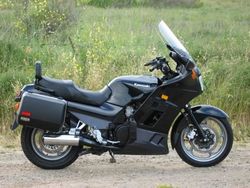 |
| Kawasaki ZG1000 Concours |
| Manufacturer |
|
| Also called |
GTR1000, Concours, ZG 1000 |
| Production |
1986 - 89 |
| Engine |
Four stroke, transverse four cylinder, DOHC, 4 valves per cylinder. |
| Compression ratio |
10.2:1 |
| Top Speed |
216.0 km/h / 134 mph |
| Ignition |
Electronic |
| Spark Plug |
NGK BA8ES '86
NGK D8EA '87-95 , '98-06 |
| Battery |
YUASA YB18L-A '86-95 , '98-06 |
| Transmission |
6 Speed |
| Suspension |
Front: 41mm Telescopic, air-assisted adjustable preload
Rear: UNI-TRAK with adjustable preload, rebound damping and air pressure |
| Brakes |
Front: 2x 272mm discs 1 piston caliper
Rear: Single 280mm disc 1 piston caliper |
| Front Tire |
120/70-18 '98-06
110/80-18 '86-95 |
| Rear Tire |
150/80-16 '86-95 , '98-06 |
| Wheelbase |
1554 mm / 61.2 in |
| Seat Height |
797 mm / 31.0 in |
| Weight |
270 kg / 595 lbs (dry), 296.0 kg / 652.6 lbs (wet) |
| Oil Filter |
K&N KN-401 |
| Fuel Capacity |
28.5 Liters / 7.5 US gal |
| Manuals |
Service Manual |
|
Reviews ·
|
The Kawasaki Concours, known in Europe as the GTR1000 and in USA as the
ZG1000, is a 997 cc, six speed, four cylinder, liquid-cooled
motorcycle with shaft drive. The bike can reach speeds over
190 km/h (120 mph), offers nimble handling and with its full fairing, tall
screen, twin locking panniers, and 28 liters (6.2 imp gal; 7.4 US gal) fuel
capacity is suited to cross-country two-up touring.
Kawasaki introduced the Concours in 1986, based on their Ninja 900 and Ninja
1000R models. Key differences between the Ninja 1000R and the ZG1000 included
32 mm instead of 36 mm carburetors, less aggressively ramped cams, shaft drive,
front and rear sub-frames, hard luggage, and full fairing. The Concours was
introduced into the USA the year after the slightly faster (137 mph) BMW K100LT
at less than two-thirds the price of the BMW machine. Both bikes were tested by
the magazine Motorcyclist, which came out in favor of the Kawasaki concluding
that it was "the most practical, useful and competent motorcycle made" and
"superior to the BMW in almost every aspect imaginable."
From 1986 to 1993 the design was largely unchanged aside from modifications
to the screen, handlebars and other very minor changes. In 1994 Kawasaki updated
the instrument cluster, forks, controls, front fender, front brakes, and the
front wheel. From 1994 to 2006, the design again experienced only minor changes:
fork protectors and exhaust tips. As the Concours first generation endured with
few revisions, experienced mechanics and used parts are readily available.
The GTR1000 has 1020 percent less horsepower than the US Concours, varying
by country
It could reach a top speed of 216.0 km/h / 134 mph.
Engine
The engine was a Liquid cooled cooled Four stroke, transverse four cylinder, DOHC, 4 valves per cylinder.. The engine featured a 10.2:1 compression ratio.
Chassis
It came with a 110/80 VR18 front tire and a 130/80 VR16 rear tire. Stopping was achieved via 2x 272mm discs 1 piston caliper in the front and a Single 280mm disc 1 piston caliper in the rear. The front suspension was a 41mm Telescopic, air-assisted adjustable preload while the rear was equipped with a UNI-TRAK with adjustable preload, rebound damping and air pressure. The ZG1000 Concours was fitted with a 28.5 Liters / 7.5 US gal fuel tank. The bike weighed just 270 kg / 595 lbs. The wheelbase was 1554 mm / 61.2 in long.
Overview
The Kawasaki ZG1000A is a motorcycle produced by Kawasaki from 1986 to 2006.
The ZG1000 Kawasaki Concours (known in Europe as GTR1000) is a 997cc, six speed, four cylinder, liquid cooled sport-touring motorcycle with a shaft drive. It has enough "sports" power to cruise at triple-digit speeds and is designed to negotiate twisty, canyon, mountain, or back-country roads with ease. With a full fairing, tall windshield, two removable locking luggage cases, and a 7.5 gallon gas tank that uses regular unleaded gas, The "Connie" will carry its pilot and passenger, plus accoutrements, across a continent in relative comfort and economy hence the "touring" part of the "sports-touring" depiction. The main difference between the GTR1000 and the American "Concours" is the GTR1000 has between 10 and 20 percent less horsepower depending on the regulations of the importing country.
The Concours may be the best definition of the "ultimate utilitarian" motorcycle, since it has been around a long time, is generally very reliable, can be used for weekend "get aways," for multi-week cross-country excursions, is an able commuter bike, can handle many errands, and is considered the best motorcycle value in its class. Often referred to as motorcycling's "Best Bang For The Buck".
In an era when the evolution of a motorcycle model may seem as short-lived as some women's fashions, the Concours is unique in having been around since 1986 without many revisions. A Concours manufactured in 1986 looks largely similar to one manufactured in 2006. Due to its longevity, many motorycle mechanics already have experience working on Concours motorcycles, which means a new owner has a better chance of receiving experienced service on the bike. As well, for a do-it-yourself mechanic, there exists a substantial market for used parts that can be purchased at reduced prices through motorcycle salvage yards. There is also a fair amount of after-market accessories available to a Concours owner to better personalize his/her vehicle.
An additional benefit to the Concours owner is the support of the Concours Owners Group which is comprised of helpful, knowledgeable and in some cases, quite passionate members who enjoy their Concours and like to help other Concours riders.
1986
1986 Kawasaki Concours in Gray
1986 Kawasaki Concours in Gray
1986 Kawasaki Concours (ZG1000-A1) in Silver
1986 Kawasaki Concours (ZG1000-A1) in Silver
1987
1987 Kawasaki Concours (ZG1000) in Maroon
1987 Kawasaki Concours (ZG1000) in Maroon
1987 Kawasaki Concours (ZG1000) in Maroon
1999
1999 Kawasaki Concours in Purple
1999 Kawasaki Concours in Purple
1999 Kawasaki Concours in Purple
1999 Kawasaki Concours in Purple
1999 Kawasaki Concours in Purple
1999 Kawasaki Concours in Purple
2000
2000 Kawasaki Concours in Red
2000 Kawasaki Concours in Red
2000 Kawasaki Concours in Red
2000 Kawasaki Concours in Red
2000 Kawasaki Concours in Red
2001
2001 Kawasaki Concours in Blue
2001 Kawasaki Concours in Blue
2001 Kawasaki Concours in Blue
2001 Kawasaki Concours in Blue
2001 Kawasaki Concours in Blue
2001 Kawasaki Concours (ZG1000-A16) in Blue
2001 Kawasaki Concours (ZG1000-A16) in Blue
2001 Kawasaki Concours (ZG1000-A16) in Blue
2001 Kawasaki Concours (ZG1000-A16) in Blue
2001 Kawasaki Concours (ZG1000-A16) in Blue
2001 Kawasaki Concours (ZG1000-A16) in Blue
2001 Kawasaki Concours (ZG1000-A16) in Blue
2002
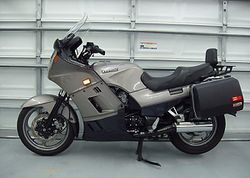
2002 Kawasaki Concours (ZG1000) in Silver
2003
2003 Kawasaki Concours (ZG1000-A18) in Red
2003 Kawasaki Concours (ZG1000-A18) in Red
2003 Kawasaki Concours (ZG1000-A18) in Red
2003 Kawasaki Concours (ZG1000-A18) in Red
2003 Kawasaki Concours (ZG1000) in Red
2003 Kawasaki Concours (ZG1000) in Red
2003 Kawasaki Concours (ZG1000) in Red
2003 Kawasaki Concours (ZG1000) in Red
2003 Kawasaki ZG1000-A18 in Maroon
2003 Kawasaki ZG1000-A18 in Maroon
2003 Kawasaki ZG1000-A18 in Maroon
2003 Kawasaki ZG1000 Concours in Maroon
2003 Kawasaki ZG1000 Concours in Maroon
2006
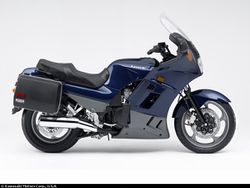
2006 Kawasaki Concours in blue
Photos
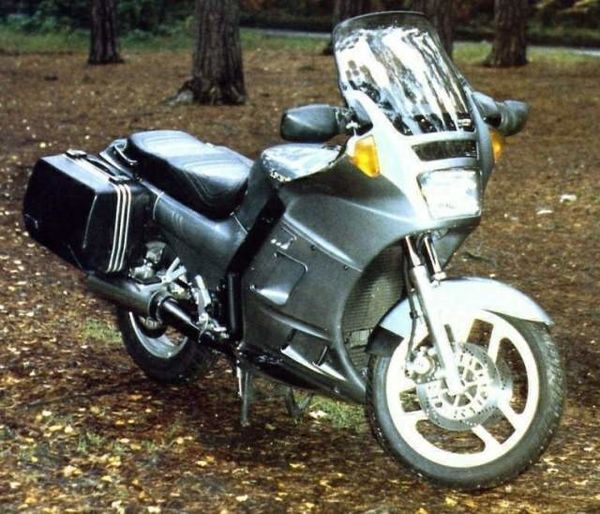
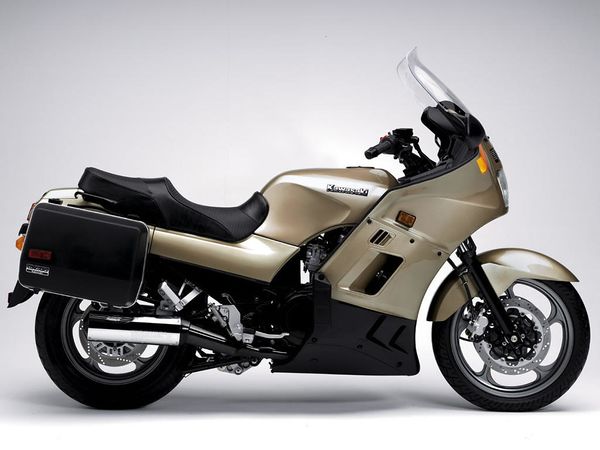
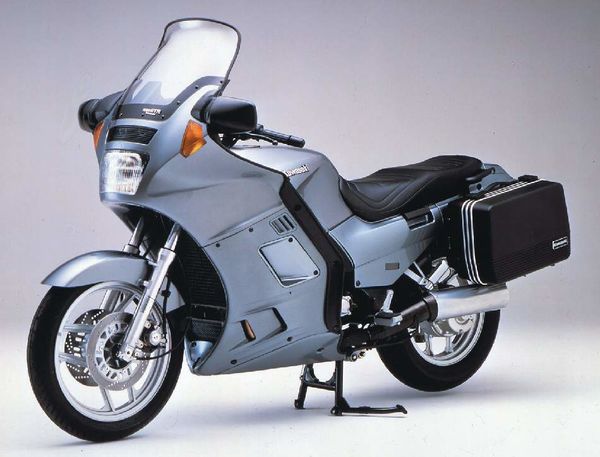
Specs
| Make Model
|
Kawasaki GTR1000 / ZG 1000 Concours
|
| Year
|
1986 - 89
|
| Engine Type
|
Four stroke, transverse four cylinder, DOHC, 4 valves per cylinder.
|
| Displacement
|
997 cc / 60.8 cu-in
|
| Bore X Stroke
|
74 x 58 mm
|
| Cooling System
|
Liquid cooled
|
| Compression
|
10.2:1
|
| Induction
|
4 x 32mm Keihin CV carburetors
|
| Ignition
|
Electronic
|
| Starting
|
Electric
|
| Max Power
|
110 hp / 85 kW @ 9500 rpm (ZG 1100 - 97 hp / 72.3 kW @ 7000 rpm)
|
| Max Power Rear Tire
|
94.4 hp / 70 kW @ 9500 rpm
|
| Max Torque
|
10 kgf-m @ 6500 rpm
|
| Transmission
|
6 Speed
|
| Final Drive
|
Shaft
|
| Front Suspension
|
41mm Telescopic, air-assisted adjustable preload
|
| Front Wheel Travel
|
140 mm / 5.5 in
|
| Rear Suspension
|
UNI-TRAK with adjustable preload, rebound damping and air pressure
|
| Rear Wheel Travcel
|
140 mm / 5.5 in
|
| Front Brakes
|
2x 272mm discs 1 piston caliper
|
| Rear Brakes
|
Single 280mm disc 1 piston caliper
|
| Front Tire
|
110/80 VR18
|
| Rear Tire
|
130/80 VR16
|
| Rake
|
28°,
|
| Trail
|
100 mm / 3.9 in
|
| Wheelbase
|
1554 mm / 61.2 in
|
| Seat Height
|
797 mm / 31.0 in
|
| Dry Weight
|
270 kg / 595 lbs
|
| Wet Weight
|
296.0 kg / 652.6 lbs
|
| Fuel Capacity
|
28.5 Liters / 7.5 US gal
|
| Consumption Average
|
14.0 km/lit
|
| Braking 60 - 0 / 100 - 0
|
15.1 m / 39.8 m
|
| Standing ¼ Mile
|
11.7 sec / 180.7 km/h
|
| Top Speed
|
216.0 km/h / 134 mph
|
External Links
Concours Owners Group (COG)

